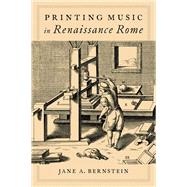Printing Music in Renaissance Rome
, by Bernstein, Jane A.- ISBN: 9780197669617 | 0197669611
- Cover: Hardcover
- Copyright: 8/4/2023
In sixteenth-century Italy, Rome ranked second only to Venice as an important center for music book production. Throughout the century, printers in the Eternal City experimented more readily and more consistently with the materiality of the book than their Venetian counterparts, who, by standardizing their printing methods, came to dominate the international marketplace. The Romans' ingenuity and willingness to meet individual clients' needs resulted in music editions in a broader array of shapes and sizes, employing a wider range of printing techniques. They became "boutique" printers, eschewing the run-of-the-mill in favor of tailoring production to varied market demands. Accommodating the diverse requirements of their clientele, they supplied customized volumes, which Venetian presses either could not--or would not--produce.
In Printing Music in Renaissance Rome, author Jane A. Bernstein offers a panoramic view of the cultures of music and the book in Rome from the beginning of printing in 1476 through the early seventeenth century. Emphasizing the exceptionalism of Roman music publishing, she highlights the innovative printing technologies and book forms devised by Roman bookmen. She also analyzes the Church's predominant influence on the book industry and, in turn, the Roman press's impact on such important composers as Palestrina, Marenzio, Victoria, and Cavalieri. Drawing on innovative publications, Bernstein reveals a synergistic relationship between music repertories and the materiality of the book. In particular, she focuses on the post-Tridentine period, when musical idioms, both new and old, challenged printers to employ alternative printing methods and modes of book presentation in the creation of their music editions. Of interest to musicologists, art historians, and book historians alike, this book builds on Bernstein's previous work as she continues to chart the course of music and the book in Renaissance Italy.
In Printing Music in Renaissance Rome, author Jane A. Bernstein offers a panoramic view of the cultures of music and the book in Rome from the beginning of printing in 1476 through the early seventeenth century. Emphasizing the exceptionalism of Roman music publishing, she highlights the innovative printing technologies and book forms devised by Roman bookmen. She also analyzes the Church's predominant influence on the book industry and, in turn, the Roman press's impact on such important composers as Palestrina, Marenzio, Victoria, and Cavalieri. Drawing on innovative publications, Bernstein reveals a synergistic relationship between music repertories and the materiality of the book. In particular, she focuses on the post-Tridentine period, when musical idioms, both new and old, challenged printers to employ alternative printing methods and modes of book presentation in the creation of their music editions. Of interest to musicologists, art historians, and book historians alike, this book builds on Bernstein's previous work as she continues to chart the course of music and the book in Renaissance Italy.






